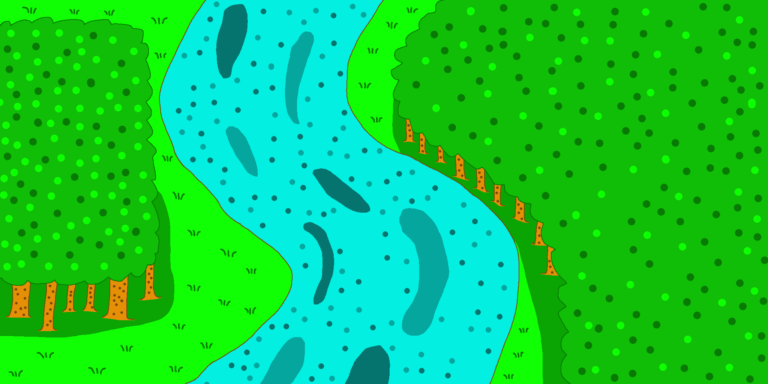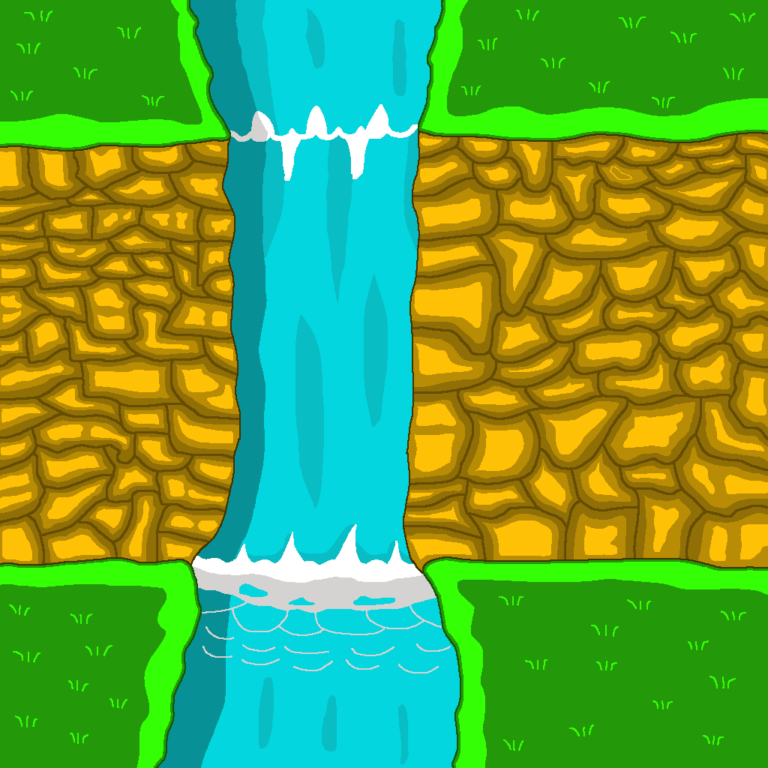Join US
Do you want to build the fantasy world you’ve always dreamed of?
Subscribe to receive notifications when a new post is out and for our monthly newsletter!
You can always unsubscribe anytime.


After making his way through the forest, the sounds of flowing water catches his attention. He turns his head to see where it’s coming from. Beckoning his horse forward, he gallops, hoping to get there before the sun sets. As he gradually gets closer, the sounds get progressively louder. It isn’t long until he reaches his destination where he observes a roaring stream of water. He finally made it to one of many fantasy rivers.
A fantasy environment, rivers come in all shapes and sizes but they all have one thing in common: they move a large volume of water from one place to another. This moving water on a large-scale leads to many creatures and plants settling near rivers from afar. People do the same thing as well.
Fantasy rivers play an important role in shaping the history of the world. Cities and towns thrive right next to them, since they need water to survive and flourish. But they also act as bottlenecks, controlling the flow of people and cargo from one place to another as people are forced to find a way to safely cross. This makes controlling rivers a key strategy in times of war.
That’s not all what rivers do. The current brings fresh water from far-off places and fish and other aquatic lifeforms. Fishermen catch them and sell them to customers who incorporate fish as part of their diet. Fantasy rivers also bring news as people ride up and down the stream to bring the latest to their rulers about the latest going-ons in the world.
In fantasy, rivers serve holistic purposes: to cleanse contamination and purge evil. Some streams carry holy water or water blessed by the world’s deity that contains the power to instantly remove contaminants like poison or cleanse the body of the evil lurking inside. That’s why you see people bathing themselves across many worlds in the genre. They’re making themselves pure and whole again.
Sadly, waterways can be twisted into evil. The servants of darkness can turn what was clean, pristine water into poison water that kills everything that comes into contact with it. This causes trouble for everything that depends on it, from the deer that drinks it to the towns and cities downstream. The poor fish who travel it wind up dead.
In the story, fantasy rivers play a significant role. Since many worlds in the genre aren’t advanced to the point where people can cross anytime and anywhere without needing a boat, they must cross a bridge instead. This leads to the hero and his party debating where to go, which can cause tension within the party though said tension is usually temporary.
Fantasy rivers are the site of key confrontations between good and evil. The servants of darkness seek to stop their foes from crossing whereas the hero and his allies wish to cross. A fight winds up breaking out and the victorious side prevails at least for the moment.
This is the fourth in a series focusing on fantasy environments. The first three featured cities, the countryside, and forests. Check them out if you want to learn more! If you want more articles, go to our blog page.
Let’s get on a boat and begin rowing down the mighty river to learn all about this incredible environment!
Fantasy rivers can be wide, narrow, and everything in-between. The wider one is, the deeper it goes. You can see the bottom of a narrow river from above since it’s relatively shallow and clear. This makes it so that anyone can cross it safely at any point without needing to search for a bridge.
On the other end of the spectrum, the wider the channel is, the more difficult it is to see the bottom since it has more water flowing through it than its shallow brethren. The water here is cloudy, which makes it tough to gauge how deep it is. If you can’t see the river’s depth, you don’t know if you can cross it safely without looking for a bridge.
Additionally, the rate of water flowing dictates how powerful it is. Wider channels have more volume than their shallow counterparts which helps them generate more force. More force equals a greater flow. You see this in the waterways of our world. Mighty ones like the Mississippi that travel hundreds of miles move water with more force and power than a mere brook that only travels twenty miles and with slow-moving water.
Putting it together, the flow of water dictates how people, animals, and communities develop in fantasy. They’re more likely to settle near narrow points in the river with a gentle flow where it’s easy and safe to cross than live near wide points with a powerful flow that necessities a bridge to cross safely.
Fishermen and other riverside communities prefer points of a river where it’s easy to get fish and put their cargo on a boat to go up and downstream. They want to make their wares easily accessible for customers in distant places and it’s considerably more difficult to do that if you’re next next to roaring water.
Fantasy rivers all have a termination point. Many end at the ocean, feeding water to it though some simply end upon meeting another channel. At some of these points, the current becomes so great, making traveling by foot impossible.
While rivers travel from higher to lower elevations at a gradual pace, some experience a drastic drop in elevation. The drop in elevation leads to one of the best phenomena in the world: waterfalls. When you see a waterfall, you can’t help but stand in awe at how beautiful it is. Waterfalls are very dangerous to navigate, both in fantasy and real world, and only those with no fear have the fortitude to do it.

Rivers also enable kingdoms to communicate with one another. The kingdoms do so by placing their agents on a boat, ferry, or cargo boat since traveling by water is faster which means the messages will reach their destinations sooner. This keeps rulers abreast of the very latest developments, especially in wartime.
Large, deep rivers are suitable for boats to traverse. The type of boat used depends on where the world was technologically. Pre-steam, boats relied on rows using human power to move though it was impossible for them to move upstream without magic. This meant that everything could only go downstream; messages, cargo, and so on had to go by road for their return.
The advent of steam technology revolutionized how rivers could be used. Steam made it possible to move up and down, paving the way for the waterways to become key commerce and delivery routes. This led to economic booms for the communities alongside them, as they could send and receive information and cargo without using roads. Steamships reigned supreme in this period.
But steam was soon eclipsed by oil and other sources of energy. This soon spurred the development of larger ships to transport goods, people, and messages. These vessels were capable of moving faster than their predecessor the steamship which meant that they reached their destinations quicker. The advancements in technology made rivers increasingly important to the kingdom’s economy. The more important a waterway was, the more likely it was to be attacked in war. Remember, rivers were key strategic values to their kingdoms, making controlling them a top priority.
Now that you understand the role fantasy rivers play in the grand scheme of things, you might be wondering how they affect the story? While they are vital in terms of worldbuilding and crafting the history of the world, when it comes to the story, they serve wholly different purposes.
At their heart, water channels act as a physical barrier to the hero, impeding his progress. This forces the hero to make a decision as to how to proceed. Sure, he could just simply turn back and call it a day but let’s be honest, that would never happen. No, the practical choice would be to determine where to cross. Many rivers have multiple bridges built in order to cross them without falling in the water. He and his party debate over where to proceed.
To generate drama, lower the number of crossings available to the hero and his allies. One suggestion is to have some in dangerous territory by having one of the characters mention something about a hostile race controlling the area that will attack those who dare cross. Another suggestion is to have bridges on the brink of collapse, making traveling more treacherous. Reducing the number of options available dovetails perfectly with the next point.
Fantasy rivers also shepherd the hero towards a confrontation with the villain’s underlings. The villain, having learned about this group working against him, dispatches his minions to stop them. He figures out where they will cross the river and places his men to stand in the hero’s path.
Having no choice but to take the best possible crossing, the hero makes his way there, only to see that his enemies are blocking his way forward. A skirmish then ensues and in most cases, the hero is victorious, driving back the villain’s servants. Occasionally, the hero is the one who loses. Regardless of who emerges the victor, the loser experiences a setback, which costs them time as they must regroup and find another path forward.
This can have ripple effects for the remainder of the story as the victor is more emboldened than before. If evil triumphs, the villain can accelerate his plans to conquer the world, believing the hero isn’t as formidable as he thought he was. If good wins, the hero believes he’s ready to face the villain himself. Both scenarios set up the victorious side to suffer a major defeat later on in the story as their brazenness results in them making a grave miscalculation that costs them far more than they anticipated.
Fantasy rivers play an integral role in the ecosystem of the world. They bring fresh water from distant lands to people, animals, and plants. Many communities were built near them so that their inhabitants had an available water source when they needed it.
Waterways are vital trade and delivery routes. Rulers receive the latest going-ons in the world so they can make the best decisions for their people. Merchants receive and sell wares, which generates money for the riverside towns and cities. This makes rivers one of the most important assets of a kingdom and thus one of the first targets to attack in wartime.
When bringing them into your world, have your audience hear the water flowing. Make it feel like they’re there in person, seeing what your characters are seeing. Have your characters bicker over where to cross it — only if it’s too dangerous to swim across safely. Your imagination is key here!
Let me know what you think in the comments below. (Note: this is an account-exclusive feature).
If you don’t have one, you can register here. It only takes a few moments of your time!
Liked this article and want to subscribe? All you have to do is fill out the form below and that’s it!
Thanks for reading this and until the next time,
Sunfire
Subscribing means you receive:
You can always unsubscribe anytime.
Do you want to build the fantasy world you’ve always dreamed of?
Subscribe to receive notifications when a new post is out and for our monthly newsletter!
You can always unsubscribe anytime.